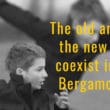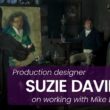In this interview, cinematographer Dick Pope walks us through a career of collaboration with Mike Leigh on films such as Peterloo, Vera Drake, and Naked. This is an excerpt from Peterloo in process, our ebook about Mike Leigh’s collaborative process.

Mike Leigh and cinematographer Dick Pope first worked together on Life is Sweet (1990), and they’ve collaborated on every one of Leigh’s films since. Pope’s history as a documentarian fit like a glove with Leigh’s process: it’s all about reacting to the energy of the actors in the moment, and Pope is thrilled by that kind of challenge. Leigh and Pope quickly became a filmmaking duo, their names intrinsically tied together.
Pope will admit himself that working with Leigh has been the highlight of his career. It led him to his second Oscar nomination (the first being for Neil Burger’s The Illusionist (2006)) for Mr. Turner (2014). It’s also earned him the clout to build ongoing working relationships with other directors such as Richard Linklater and Gurinder Chadha.
I met Dick Pope at the BFI in London to interview him about his career working with Leigh. He had just emerged from a restoration screening of Naked (1993), positively glowing after being reminded of the greatness of a film he hadn’t revisited for nearly 30 years. He was more than ready to gush about working with Leigh.
Seventh Row (7R): Could you describe how you fit into Mike Leigh’s process, from the point when you’re brought onto a project to when you’re done with it?
Dick Pope: Since I met him, which is nearly 30 years ago, it’s always been the same for me, every one — and I’ve done 13 with him. Before I joined him, I know that his process of working was the same through everything he did. That’s never changed, and it never will.
For Peterloo, there was pressure to bring on a storyboard artist because it was such a big crowd, and it was so complicated, but Mike absolutely refused to do that. He wanted to do it his own way.
On the day, he makes up the scene from scratch with the actors there, all of whom are in character, knowing exactly who they are as characters. He will go off with those actors and bring a scene to the table. It’s a private affair: only Mike and the actors and the script supervisor are present. I’m never at the rehearsals, ever. I have no access to them. That is the day-to-day working practice.
Sometimes, he’ll show us quite a lot of scenes together, especially if we’re taking a break. Sometimes, we take a break towards the end of a film for about a week. We did on Peterloo. We did on Mr. Turner, I think. It’s when he just needs a week with the actors to bring the film to a climax. So we’ll lose ourselves for a week, go on a little holiday. We come back, and he’ll show us a body of work. Famously, that was the case on Secrets & Lies [(1996)], where he showed us a huge amount of work that we had to get done by that night. But usually, we’ve got a few days that we can do it in.
He will bring a scene to us, and the whole company will watch that scene. Then, Mike and I will devise how to shoot it. Everybody comes into a room and stands against a wall. Mike’s been off rehearsing with the actors. He’ll come in with the actors, and they’ll play the scene for us, and everybody watches it — in full view of what we’ve already done. The films are often organically chronological: we start off at the very beginning and end at the end. Wherever the actors are at this moment in time, that’s where the scene will be.
The actors will show it to us, and then everybody will clear off except the actors, Mike, and myself. In a quiet environment, without the rest of the crew looking on, there’s a quiet affair of him and I working out how we’re going to shoot the scene. He’ll ask me how long he thinks it will take to get together. I’ll give him an honest answer, and then he’ll go off with the actors and work on that scene to really hone it into completion. Or if that scene’s already complete, he’ll work on perhaps another scene with those actors.
That’s the same with two people just sitting there talking or with 60,000 people in the square [in Peterloo], when a protest and a riot ensues: same working practice. He’ll go in there, and he’ll work out how to do the scene without anybody around him — just him and the actors — and then we go from there.
I’ve always described it as a bit of a magical mystery tour, because you don’t really know what you’re getting into. I mean, sure, on Peterloo, you knew it was about the Peterloo massacre. On Mr. Turner, we knew it was about Turner the painter. But usually, we do not know what the film is about. We just see it in sections.
How Dick Pope prepares for a shoot
7R: When Mike first comes to you and tells you that he’s working on a new project, obviously, you don’t have much information, although with historical films you have a bit. But with original character studies like Happy-Go-Lucky (2008) or Secrets & Lies, what kind of information do you get at the start? How are those projects born?
Dick Pope: With Secrets & Lies, there wasn’t that much information, although I did have an idea about it. I had an idea that it was about a young black woman seeking her birth mother.
On a film like Vera Drake [(2004)], I knew that was about an abortionist, I knew that it was set after the Second World War. So my tests reflected that era. Jacqueline had been thinking about the costumes, so I threw the stand-in people into those clothes and did a test on that period: the 1950s, backstreets of London, poor council estates…
On Naked [(1993)], the second film I did with him, he told me that he wanted to make a Dickensian journey through the underworld of London at night, with lots of sex and goings on. That’s what it turned out to be. It was the end of Thatcher’s Britain, a pretty grim London, and this crazy Rimbaud-type poet character played by David Thewlis. It was all about his journey through London, meeting people, like a sort of Canterbury Tales for the modern era.
Happy-Go-Lucky is a more difficult one to get to terms with. If I remember rightly, it was decided to be about a very, very up and optimistic young woman who always saw the bright side of life and wouldn’t be brought down. And of course, Mike Leigh will find the cracks within her relationships with people.
To read the rest of the interview with Dick Pope, purchase the book
Discover how Mike Leigh and his team work their magic.

